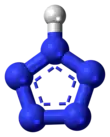Pentazole
Pentazole is an aromatic molecule consisting of a five-membered ring with all nitrogen atoms, one of which is bonded to a hydrogen atom. It has the molecular formula HN5. Although strictly speaking a homocyclic, inorganic compound, pentazole has historically been classed as the last in a series of heterocyclic azole compounds containing one to five nitrogen atoms. This set contains pyrrole, imidazole, pyrazole, triazoles, tetrazole, and pentazole.
| |||
| Names | |||
|---|---|---|---|
| Systematic IUPAC name
1H-Pentazole[1] | |||
| Identifiers | |||
3D model (JSmol) |
|||
| ChemSpider | |||
PubChem CID |
|||
CompTox Dashboard (EPA) |
|||
| |||
| |||
| Properties | |||
| N 5H | |||
| Molar mass | 71.0414 g/mol | ||
Except where otherwise noted, data are given for materials in their standard state (at 25 °C [77 °F], 100 kPa).
Infobox references | |||
Derivatives
Substituted analogs of pentazole are collectively known as pentazoles. As a class, they are unstable and often highly explosive compounds. The first pentazole synthesized was phenylpentazole, where the pentazole ring is highly stabilized by conjugation with the phenyl ring. The derivative 4-dimethylaminophenylpentazole is among the most stable pentazole compounds known, although it still decomposes at temperatures over 50 °C. It is known that electron-donating groups stabilize aryl pentazole compounds.[2]
Ions
The cyclic pentazolium cation (N+
5) is not known due to its probable antiaromatic character; whereas the open-chained pentazenium cation (N+
5) is known. Butler et al. first demonstrated the presence of the cyclic N−
5 in solution through the decomposition of substituted aryl pentazoles at low temperature. The presence of N
5H and N−
5 (held in solution through the interaction with zinc ions) was proven primarily using 15N NMR techniques of the decomposition products.[3] These results were initially challenged by some authors,[4] but subsequent experiments involving the detailed analysis of the decomposition products, complemented by computational studies, bore out the initial conclusion.[5][6][7] The pentazolide anion is not expected to last longer than a few seconds in aqueous solution without the aid of complexing agents. The discovery of pentazoles spurred attempts to create all-nitrogen salts such as N+
5N−
5, which should be highly potent propellants for space travel.
In 2002, the pentazolate anion was first detected with electrospray ionization mass spectrometry[8] In 2016, the ion was also detected in solution.[9] In 2017, white cubic crystals of the pentazolate salt, (N5)6(H3O)3(NH4)4Cl were announced. In this salt, the N−
5 rings are planar. The bond lengths in the ring are 1.309 Å, 1.310 Å, 1.310 Å, 1.324 Å, and 1.324 Å.[10] When heated, the salt is stable up to 117 °C, and over this temperature it decomposes to ammonium azide.[10] Under extreme pressure conditions, the pentazolate ion was also synthesized. It was first obtained in 2016 in the form of the CsN5 salt by compressing and laser-heating a mixture of CsN3 embedded in molecular N2 at 60 GPa. Following the pressure release, it was found metastable down to 18 GPa.[11] In 2018, another team reported the high pressure synthesis of LiN5 above 45 GPa from a pure lithium surrounded by molecular nitrogen. This compound could be retained down to ambient conditions after the complete release of pressure.[12]
References
- "1H-Pentazole - PubChem Public Chemical Database". The PubChem Project. USA: National Center for Biotechnology Information.
- Burke, L. A.; Fazen P. J. (Dec 2009). "Correlation Analysis of the Interconversion and Nitrogen Loss Reactions of Aryl Pentazenes and Pentazoles Derived From Aryl Diazonium and Azide Ions". International Journal of Quantum Chemistry. 109 (15): 3613–3618. Bibcode:2009IJQC..109.3613B. doi:10.1002/qua.22408.
- Butler, R. N.; Stephens, John C.; Burke, Luke A. (2003). "First generation of pentazole (HN5, pentazolic acid), the final azole, and a zinc pentazolate salt in solution: A new N-dearylation of 1-(p-methoxyphenyl) pyrazoles, a 2-(p-methoxyphenyl) tetrazole and application of the methodology to 1-(p-methoxyphenyl) pentazole". Chemical Communications (8): 1016–1017. doi:10.1039/b301491f. PMID 12744347.
- Schroer T, HaigesR, Schneider S, Christe KO (2004-12-31). "The race for the first generation of the pentazolate anion in solution is far from over". Chemical Communications (12): 1607–9. doi:10.1039/B417010E. PMID 15770275.
- Butler RN, Hanniffy JM, Stephens JC, Burke LA (2008-01-31). "A Ceric Ammonium Nitrate N-Dearylation of N-p-Anisylazoles Applied to Pyrazole, Triazole, Tetrazole, and Pentazole Rings: Release of Parent Azoles. Generation of Unstable Pentazole, HN5/N5-, in Solution" (PDF). The Journal of Organic Chemistry. 73 (4): 1354–1364. doi:10.1021/jo702423z. PMID 18198892.
- Perera SA, Gregusová A, Bartlett RJ (2009-04-01). "First Calculations of 15N−15N J Values and New Calculations of Chemical Shifts for High Nitrogen Systems: A Comment on the Long Search for HN5 and Its Pentazole Anion". The Journal of Physical Chemistry A. 113 (13): 3197–3201. Bibcode:2009JPCA..113.3197P. doi:10.1021/jp809267y. PMID 19271757.
- "Galway discovery ahead of the world". The Irish Times. Aug 13, 2009.
- Vij, A., Pavlovich, J. G., Wilson, W. W., Vij, V. and Christe, K. O. (2002), Experimental Detection of the Pentaazacyclopentadienide (Pentazolate) Anion, cyclo-N5−. Angew. Chem. Int. Ed., 41: 3051–3054. doi:10.1002/1521-3773(20020816)41:16<3051::AID-ANIE3051>3.0.CO;2-T
- B. Bazanov, U. Geiger, R. Carmieli, D. Grinstein, S. Welner, Y. Haas,Detection of Cyclo-N5− in THF Solution Angew. Chem. Int. Ed. 2016, 55, 13233.doi:10.1002/anie.201605400
- Zhang, Chong; Sun, Chengguo; Hu, Bingcheng; Yu, Chuanming; Lu, Ming (26 January 2017). "Synthesis and characterization of the pentazolate anion cyclo-N5ˉ in (N5)6(H3O)3(NH4)4Cl". Science. 355 (6323): 374–376. Bibcode:2017Sci...355..374Z. doi:10.1126/science.aah3840. PMID 28126812. S2CID 206651670.
- Steele, Brad A.; Stavrou, Elissaios; Crowhurst, Jonathan C.; Zaug, Joseph M.; Prakapenka, Vitali B.; Oleynik, Ivan I. (2016-12-06). "High-Pressure Synthesis of a Pentazolate Salt". Chemistry of Materials. 29 (2): 735. arXiv:1612.01918. doi:10.1021/acs.chemmater.6b04538. ISSN 0897-4756. S2CID 99194135.
- Laniel, D.; Weck, G.; Gaiffe, G.; Garbarino, G.; Loubeyre, P. (2018-03-13). "High-Pressure Synthesized Lithium Pentazolate Compound Metastable under Ambient Conditions". The Journal of Physical Chemistry Letters. 9 (7): 1600–1604. doi:10.1021/acs.jpclett.8b00540. ISSN 1948-7185. PMID 29533665.

